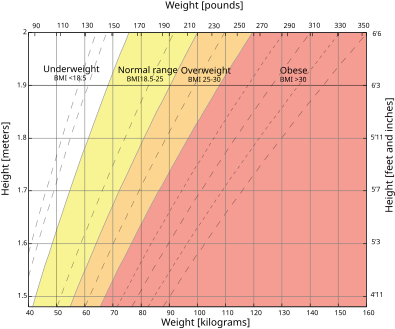The Body Mass Index (BMI), or Quetelet index, is a measure for human body shape based on an individual's mass and height. Devised between 1830 and 1850 by the Belgian polymath Adolphe Quetelet during the course of developing "social physics". It is defined as the individual's body mass divided by the square of their height – with the value universally being given in units of kg/m2.
 |  | |
|---|---|---|
 † † |
† The factor for UK/US units is more precisely 703.06957964, but that level of precision is not meaningful for this calculation.
BMI can also be determined using a table or from a chart which displays BMI as a function of mass and height using contour lines, or colors for different BMI categories. Such charts can easily allow two different sets of units of measurement to be used, which is often useful.
The BMI is used in a wide variety of contexts as a simple method to assess how much an individual's body weight departs from what is normal or desirable for a person of his or her height. There is however often vigorous debate, particularly regarding at which value of the BMI scale the threshold for overweight and obese should be set, but also about a range of perceived limitations and problems with the BMI.
Despite a wide range of other, differently calculated, ratios having been proposed.
None have yet been as widely adopted.
Health consequences of overweight and obesity in adults
The BMI ranges are based on the relationship between body weight and disease and death. Overweight and obese individuals are at increased risk for many diseases and health conditions, including the following:
- Hypertension
- Dyslipidemia (for example, high LDL cholesterol, low HDL cholesterol, or high levels of triglycerides)
- Type 2 diabetes
- Coronary heart disease
- Stroke
- Gallbladder disease
- Osteoarthritis
- Sleep apnea and respiratory problems
- Some cancers (endometrial,[18] breast, and colon).
BMI is proportional to mass. However, for a given mass, BMI is inversely proportional to the square of the height. So, if all body dimensions double, and mass scales naturally with the cube of the height, then BMI doubles instead of remaining the same. This results in taller people having a reported BMI that is uncharacteristically high compared to their actual body fat levels. In comparison, the Ponderal index is based on this natural scaling of mass with the third power of the height. However, many taller people are not just "scaled up" short people, but tend to have narrower frames in proportion to their height. Nick Korevaar (a mathematics lecturer from the University of Utah) suggests that instead of squaring the body height (an exponent of 2, as the BMI does) or cubing the body height (an exponent of 3, as the Ponderal index does), it would be more appropriate to use an exponent of between 2.3 and 2.7[6] (as originally noted by Quetelet). (For a theoretical basis for such values see MacKay.
BMI Prime, a simple modification of the BMI system, is the ratio of actual BMI to upper limit BMI (currently defined at BMI 25). As defined, BMI Prime is also the ratio of body weight to upper body weight limit, calculated at BMI 25. Since it is the ratio of two separate BMI values, BMI Prime is a dimensionless number, without associated units. Individuals with BMI Prime less than 0.74 are underweight; those between 0.74 and 1.00 have optimal weight; and those at 1.00 or greater are overweight. BMI Prime is useful clinically because individuals can tell, at a glance, by what percentage they deviate from their upper weight limits. For instance, a person with BMI 34 has a BMI Prime of 34/25 = 1.36, and is 36% over his or her upper mass limit. In South East Asian and South Chinese populations (see international variation section below) BMI Prime should be calculated using an upper limit BMI of 23 in the denominator instead of 25. Nonetheless, BMI Prime allows easy comparison between populations whose upper limit BMI values differ.
Categories
A frequent use of the BMI is to assess how much an individual's body weight departs from what is normal or desirable for a person of his or her height. The weight excess or deficiency may, in part, be accounted for by body fat (adipose tissue) although other factors such as muscularity also affect BMI significantly (see discussion below and overweight). The WHO regards a BMI of less than 18.5 as underweight and may indicate malnutrition, an eating disorder, or other health problems, while a BMI greater than 25 is considered overweight and above 30 is considered obese. These ranges of BMI values are valid only as statistical categories
| Category | BMI range – kg/m2 | BMI Prime |
|---|---|---|
| Very severely underweight | less than 15 | less than 0.60 |
| Severely underweight | from 15.0 to 16.0 | from 0.60 to 0.64 |
| Underweight | from 16.0 to 18.5 | from 0.64 to 0.74 |
| Normal (healthy weight) | from 18.5 to 25 | from 0.74 to 1.0 |
| Overweight | from 25 to 30 | from 1.0 to 1.2 |
| Obese Class I (Moderately obese) | from 30 to 35 | from 1.2 to 1.4 |
| Obese Class II (Severely obese) | from 35 to 40 | from 1.4 to 1.6 |
| Obese Class III (Very severely obese) | over 40 | over 1.6 |
